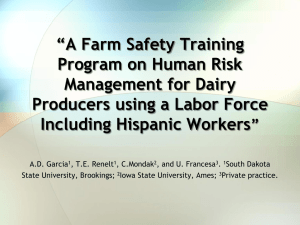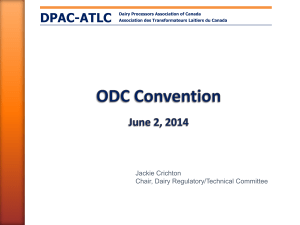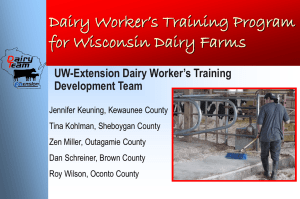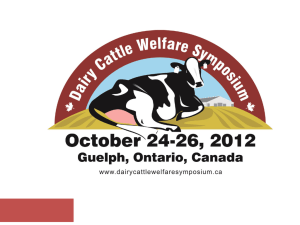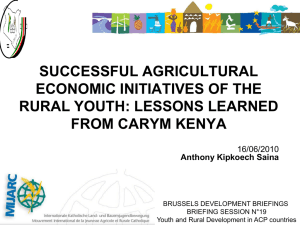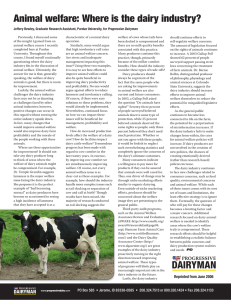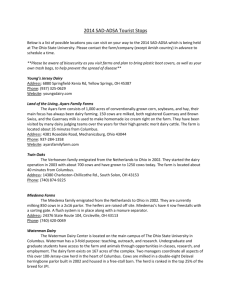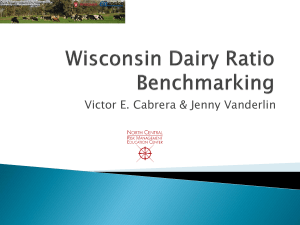PowerPoint Presentation Male Female PowerPoint Presentation
advertisement
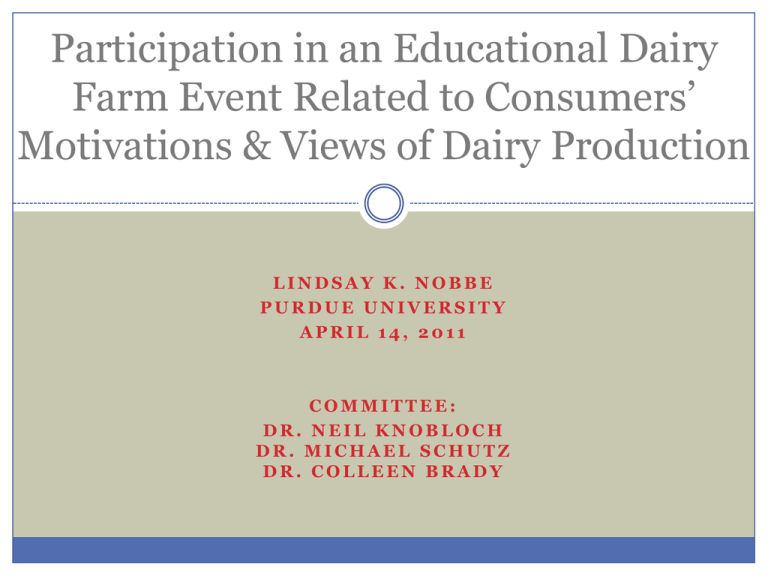
Participation in an Educational Dairy Farm Event Related to Consumers’ Motivations & Views of Dairy Production LINDSAY K. NOBBE PURDUE UNIVERSITY APRIL 14, 2011 COMMITTEE: DR. NEIL KNOBLOCH DR. MICHAEL SCHUTZ DR. COLLEEN BRADY Introduction Dwindling Food Supply Confidence • <2% of American population actively involved in agriculture (Arkansas Foundation for Agriculture, Agricultural Educational Programs • Consumer knowledge & confidence in food products & production (MPSI, 2010b; United Soybean Example: Dairy Industry 2006) • Questioning production practices & safety (Tucker, Whaley, Sharp, 2005; Doerfert et al., 2005) Board, 2011) • Improve consumer diet (MPSI, 2010b; United Soybean Board, 2011) • Inform food purchasing decisions • Brunch on the Farm • Successful based on anecdotal evidence ONLY Purpose of the Study To explain & predict consumers’ participation in an educational dairy farm event based on: Motivations RQ 2 & 3 Views Channels RQ 1 Sources Dairy Consumption RQ 4 Conceptual Framework Brunch on the Farm Attendance Consumer Motivations Enjoyment Consumer Views of Dairy Industry Health Social Desire Competence Social Comparison (Deci & Ryan, 1991) Animal Welfare Practices Food Safety Practices Environmental Care Practices (Wimberley et al., 2003) Theoretical Framework SelfDetermination Theory • Individuals are active & naturally strive for self-growth, mastery of challenges, & integration of new experiences • Focus in education, psychotherapy, work, & sports Basic Human Values Theory • Values: refer to desirable goals, transform actions into situations, are the standards by which actions are determined & judged, and are prioritized • Minimal research (Deci & Ryan, 1991) (Schwartz, 1996) Review of Literature Agritourist Motivations • Experiencing agriculture, participating in adventure, relaxing, & leisure enjoyment (Carpio et al., 2006; Miller, 2006) Environmental Care Views • Closer residents were more likely to complain (Jones et al., n.d.) • Water & soil contamination were greatest dairy farm complaint Animal Welfare Views Food Safety Views (Jones et al., n.d.) • Most research on actual animal welfare practices, not views (Center for Food Economics Research [CFER], 2001) • Animal welfare important to Indiana consumers (Truitt, 2010) • Farmers are responsible for proper treatment (Truitt, 2010) • No studies focused on dairy products • Bacterial contamination & pesticide residues were a food concern (Jones et al., n.d.) • Consumers want to know about practices used to produce safe food (Food Systems Insider, 2010) Methodology DATA COLLECTION INSTRUMENT RESPONDENTS Data Collection Simple Random Sample (1,201 households) N = 565 (36% response rate) Participants (n = 48) Non-participants (n = 154) Geographic area (U.S. Census Bureau, 2010) Largest City Pop. = 17,800 Smallest Town Pop. = <200 Mail survey (Dillman, Smyth, & Christian, 2009) 4 mailings 8 weeks (Sept.-Nov.) Non-response error was controlled Instrument Part 1: Motivations 2: Views 3.1: Information Variable # of items Cronbach’s α Pilot Post-hoc Health 4 .96 .92 Social Desire 4 .76 .72 Social Comparison 4 .89 .75 Competence 4 .90 .90 Enjoyment 4 .89 .85 Animal Welfare Practices 6 .77 .68 Environmental Care Practices 7 .83 .77 Food Safety Practices 7 .83 .74 Channels Used 13 N/A N/A never = 1 sometimes = 2 always = 3 Sources Trusted 13 N/A N/A not at all = 1 slightly = 2 somewhat = 3 mostly = 4 always = 5 Demographics 22 N/A N/A Multiple Used 3.2: Information 4 Scale not at all = 1 slightly = 2 somewhat = 3 mostly = 4 always = 5 strongly disagree = 1 disagree = 2 agree = 3 strongly agree = 4 Respondents Age in Years (n =Income 194) (n = 199) Average Annual Household Gender (n = 201) 4.1% 7.4% 3.6% 8.2% 16.7% 9.9% 18.6% 15.8% Female 62% 20.7% 34.0% < $25,000 $25,000 - $49,999 20-29 $50,000 - $74,999 30-39 Male - $99,999 40-49 38%$75,000 31.4% 50-59 ≥ $100,000 60-69 Prefer not to answer 27.6% 70-79 Views of Dairy Industry Practices Conclusion 1: Similar Views of the Dairy Industry’s Animal Welfare, Environmental Care, & Food Safety Practices Food Safety p = .01* d = .38 Environmental Care p = .03* d = .38 Animal Welfare p = .09 d = .33 1 2 3 Nonparticipants (N = 142) Participants (N = 44) 4 Mean Scale: 1 = strongly disagree, 2 = disagree, 3 = agree, 4 = strongly agree Motivation Conclusion 2: Participants Were More Motivated to Attend Educational Dairy Farm Events Social Comparison p < .01* d = .52 Social Desire p < .01* d = .61 Competence p < .01* d = .62 Enjoyment p < .01* d = .94 Health p < .01* d = .54 1 2 3 4 Nonparticipants (N = 142) Participants (N = 44) 5 Mean Scale: 1 = not at all, 2 = slightly, 3 = somewhat, 4 = mostly, 5 = always Conclusion 3: Prediction of Consumer Participation Health Ag Familiarity Animal Welfare Practices Competence Enjoyment Participation Household Consumed ≥3 Gallons Milk/Week 73.0% of original grouped cases correctly classified with this model. Conclusion 4: Differences in Food Purchasing Information Channels Consumer of Educational Events Consumer UseUse of Family &/or Friends as as Food Food Purchasing Information Channel Purchasing Information Channel 90.0% 80.00% 80.0% 70.00% 70.0% 60.0% 50.0% 60.00% 50.00% Participants Participants (N =(N = 48) 48) Nonparticipants (N = Nonparticipants (N =154) 154) 40.0% 40.00% 30.0% 30.00% 20.0% 20.00% 10.0% 10.00% 0.0% 0.00% Never Never Sometimes Sometimes Always Always Scale: 1 = Never, 2 = Sometimes, 3 = Always p < 05* p < 05* Implications Consumer Participation Prediction Model More Appealing Program Development & Marketing More Effective & Efficient Key Message Communication Recommendations Alternative Data Collection Continuation of Theory Development Replication in Other Contexts Acknowledgements COMMITTEE: DR. NEIL KNOBLOCH DR. MICHAEL SCHUTZ DR. COLLEEN BRADY SPONSORS: INDIANA SOYBEAN ALLIANCE MILK PROMOTION SERVICES OF INDIANA DEPT. OF YDAE DR. NEIL KNOBLOCH Questions & Comments THANK YOU! Google Images


